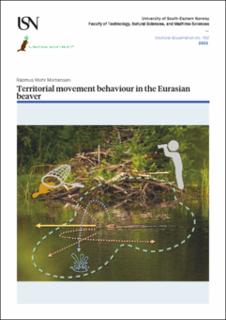| dc.contributor.author | Mortensen, Rasmus Mohr | |
| dc.date.accessioned | 2023-05-25T14:10:11Z | |
| dc.date.available | 2023-05-25T14:10:11Z | |
| dc.date.issued | 2023-06-09 | |
| dc.identifier.isbn | 978-82-7206-776-1 | |
| dc.identifier.issn | 2535-5252 | |
| dc.identifier.uri | https://hdl.handle.net/11250/3069039 | |
| dc.description.abstract | It can be challenging to observe and quantify natural behaviour in wild free-ranging animals. Species that are reclusive or exploit multiple environments, such as semi-aquatic mammals, may be particularly difficult to study. Fortunately, deployment of animal-borne telemetry devices has rapidly improved our understanding of movement, behaviour, and physiology in free-ranging individuals with increasing spatiotemporal resolution and accuracy. However, deployment of tracking devices often requires multiple capture and handling events of individuals, and ecologists may additionally use long-term individual-based studies to get a better understanding of patterns and mechanisms. This, together with the tracking device itself, may have considerable behavioural effects on the individual and potentially have considerable consequences for individual fitness and the dynamics of the population.
In this thesis, we aimed to investigate natural spatiotemporal dynamics in the territorial movement behaviour in free-ranging individuals of a territorial, semi-aquatic mammal, the Eurasian beaver (Castor fiber). We combined a long-term individual-based monitoring project (the Norwegian Beaver Project) with sophisticated animal-borne dataloggers to study the natural movement behaviour of various individuals throughout the night and across seasons in habitats that are often difficult to observe (e.g., the aquatic environment). Furthermore, we evaluated short- and long-term effects from repeated capture and handling of individuals which can have considerably effects on the reliability of our ecological research.
In the first part, we showed how the combination of fine-scaled dead-reckoned movement tracks together with behavioural segmentation of the tracks can reveal how individuals allocate time to various activities, with focus on aquatic behaviours. We show how individuals perform dives of short duration and allocate little time to diving activities, indicating the energetic constraints. Furthermore, we show how timing and location of diving activities are highly shaped according to the activity peaks of predators, as well as by activities connected to the territory borders.
In the second part, we investigated how individuals moved and exploited the territory. Beavers strongly selected, both aquatic and terrestrial, habitats located closer to the riverbank, indicating the energetic costs. Habitat use and movement patterns revealed how beavers perceive the aquatic environment as safe and suggest that movement and selection of habitats are highly shaped according to individuals’ perception of risk, social interactions, and energetic requirements.
In the third part, we investigated short- and long-term effects of repeated capture and handling according to movement behaviour and fitness-related metrics. We show that adult individuals can adjust their movements according to perceived risk and disturbances within the territory, both in the short- and in the long-term, whereas younger individuals may be less capable of adjusting, possibly because of varying energetic requirements related to their fitness potential. Consequently, capture and handling may cause territorial animals to exploit the territory, temporally and spatially, in a less predictable manner to reduce potential risk from predators and researchers in the field. Lastly, we show how repeated capture and handling can affect important life stages in individuals. Body mass in dominant individuals were negatively affected by number of capture events, however, other individuals may not be able to adapt to the increased stress because of other ecological drivers. Number of captures furthermore negatively affected reproduction in the early years of monitoring, but the effect decreased with time, indicating possible habituation. We found no effects on survival.
Overall, we show the potential of using multiple biologging data to improve our knowledge and understanding of animal movement and behavioural dynamics in wild free-ranging individuals that may be challenging to study. Furthermore, we illustrate the validity of long-term individual-based studies and show the importance of investigating several condition-related categories, at multiple times, when evaluating the consequences of capturing and handling individual animals. | en_US |
| dc.language.iso | eng | en_US |
| dc.publisher | University of South-Eastern Norway | en_US |
| dc.relation.ispartofseries | Doctoral dissertations at the University of South-Eastern Norway;162 | |
| dc.relation.haspart | Paper I: Mortensen, R.M., Reinhardt, S., Hjønnevåg, M.E., Wilson, R.P. & Rosell, F.: Aquatic habitat use in a semi-aquatic mammal: the Eurasian beaver. Animal Biotelemetry, 9(1), (2021), 1-19. https://doi.org/10.1186/s40317-021-00259-7 | en_US |
| dc.relation.haspart | Paper II: Mortensen, R.M., Wilson, R.P. & Rosell, F.: A territorial semi-aquatic mammal reduces predictable movements within the territory as a response to short- and long-term capture effects. Manuscript prepared for submission to Movement Ecology | en_US |
| dc.relation.haspart | Paper III: Mortensen, R.M. & Rosell, F.: Long-term capture and handling effects on body condition, reproduction, and survival in a semi-aquatic mammal. Scientific Reports, 10, 17886, (2020). https://doi.org/10.1038/s41598-020-74933-w | en_US |
| dc.rights.uri | http://creativecommons.org/licenses/by-nc-sa/4.0/deed.no | |
| dc.subject | castor fiber | en_US |
| dc.subject | eurasian beaver | en_US |
| dc.subject | animal welfare | en_US |
| dc.subject | biologging | en_US |
| dc.subject | capture stress | en_US |
| dc.subject | movement ecology | en_US |
| dc.subject | research ethics | en_US |
| dc.subject | territoriality | en_US |
| dc.title | Territorial movement behaviour in the Eurasian beaver | en_US |
| dc.type | Doctoral thesis | en_US |
| dc.description.version | publishedVersion | en_US |
| dc.rights.holder | © The Author, except otherwise stated | en_US |
| dc.subject.nsi | VDP::Mathematics and natural science: 400::Zoology and botany: 480::Ecology: 488 | en_US |

